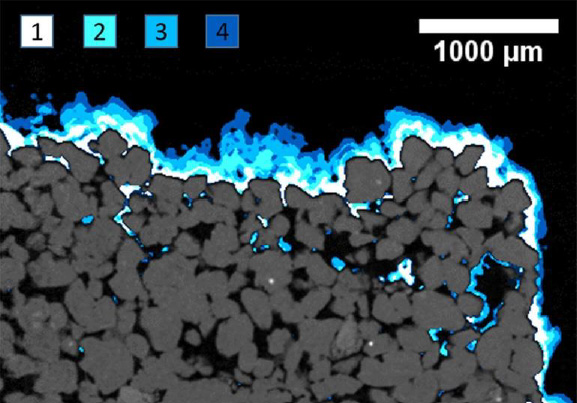Using Micro-XRF Mapping in Earth Exploration
Micro-XRF is an analysis technique frequently used for geology applications such as analysing rocks and minerals, elemental mapping, material characterisation, sedimentology and many others. Micro-XRF utilises X-rays to analyse materials quickly and on a tiny scale which is then used to create an image, known as an elemental distribution map, to highlight specific samples. In this blog post, we will outline how Micro-XRF is used for mapping in earth exploration.
What is Micro-XRF?
Microscopic X-ray fluorescence (micro-XRF) is used to analyse samples from a few millitmeters to a few centimeters in a non-destructive way. In simple terms, micro-XRF helps to identify the elemental composition of a sample, which can then be used to produce a coloured map of the chosen sample’s surface. For the method to work, X-rays excite the atoms in the sample to induce fluorescence. The X-ray beams are then focused onto a tiny spot, which allows the scientist to map surface elements and gain information about the sample’s composition.
Micro-XRF is a crucial component in various applications, but it is commonly used for elemental surface mapping and composition analysis. Some of the benefits of using micro-XRF include its non-invasiveness an negligible sample preparation requirements, additional benefits include:
- Fast measurements (0.3ms per pixel)
- High spatial resolution (<20 µm X-ray spot size)
- Suitable for irregular shapes
- Versatile for a range of industries
Mapping in Earth Exploration
Micro-XRF is used to analyse samples from the earth to determine what the sample is, what other elements are within it, and where those elements are positioned. The pieces that scientists might need to analyse could be natural, such as rocks, soil or other samples, but they could also be manufactured artefacts, like ceramics or coins, that have been buried in the earth. The discovery of buried items often helps scientists and archaeologists learn more about our past and how our present developed. A further two examples will be outlined below.

Cross-section of the same rock with evolution of the salt crust in 4 cycles of saturation with salt liquid and drying at atmospheric conditions.
Element Distribution
Micro-XRF is the ideal solution to analyse elements and minerals within geological samples. The technique will allow scientists to identify elements and the sample’s elemental distribution and crystal structure. Typical samples include bones and fossils, graphite, minerals and more, and once the elements have been identified, elemental distribution maps can be created.
Sediment Cores
Sediment cores are often found in lakes and marine environments and are analysed to find more information about climate change, extreme weather events and pollution. By extracting data from sediment cores, scientists can understand what elements are in the samples and determine whether they were impacted by floods, hurricanes, pollutants and other environmental situations.
Micro-XRF with Blue Scientific
If your applications require the generation of large elemental distribution maps, then the Bruker M4 TORNADO or M6 JETSTREAM might be the perfect solution for you. Using micro-XRF, high-resolution maps can be produced to provide visual information on the elemental distribution of your sample.
Additionally, we offer the M4 TORNADOAMICS; the world’s first automated mineral identification system based on micro-XRF. Using advanced imaging techniques, the AMICS software enables users ot automate critical minerarology tasks such as phase identification and characterization.
Blue Scientific are the UK’s official distributor of Bruker micro-XRF instruments, and we are available to help provide information on their products or the applications of micro-XRF. Whether you’re looking to purchase or have questions about what we offer, please don’t hesitate to get in touch.

